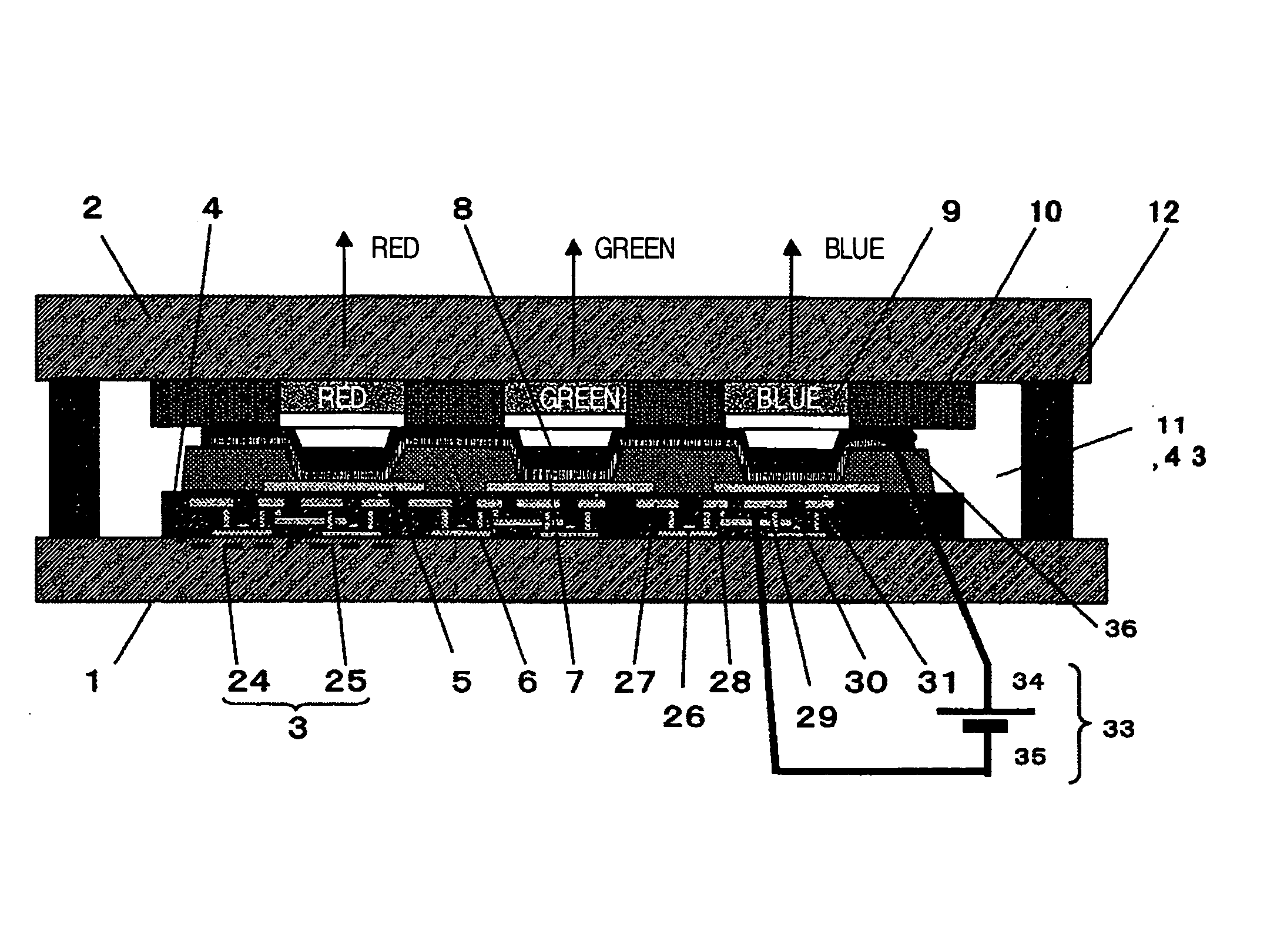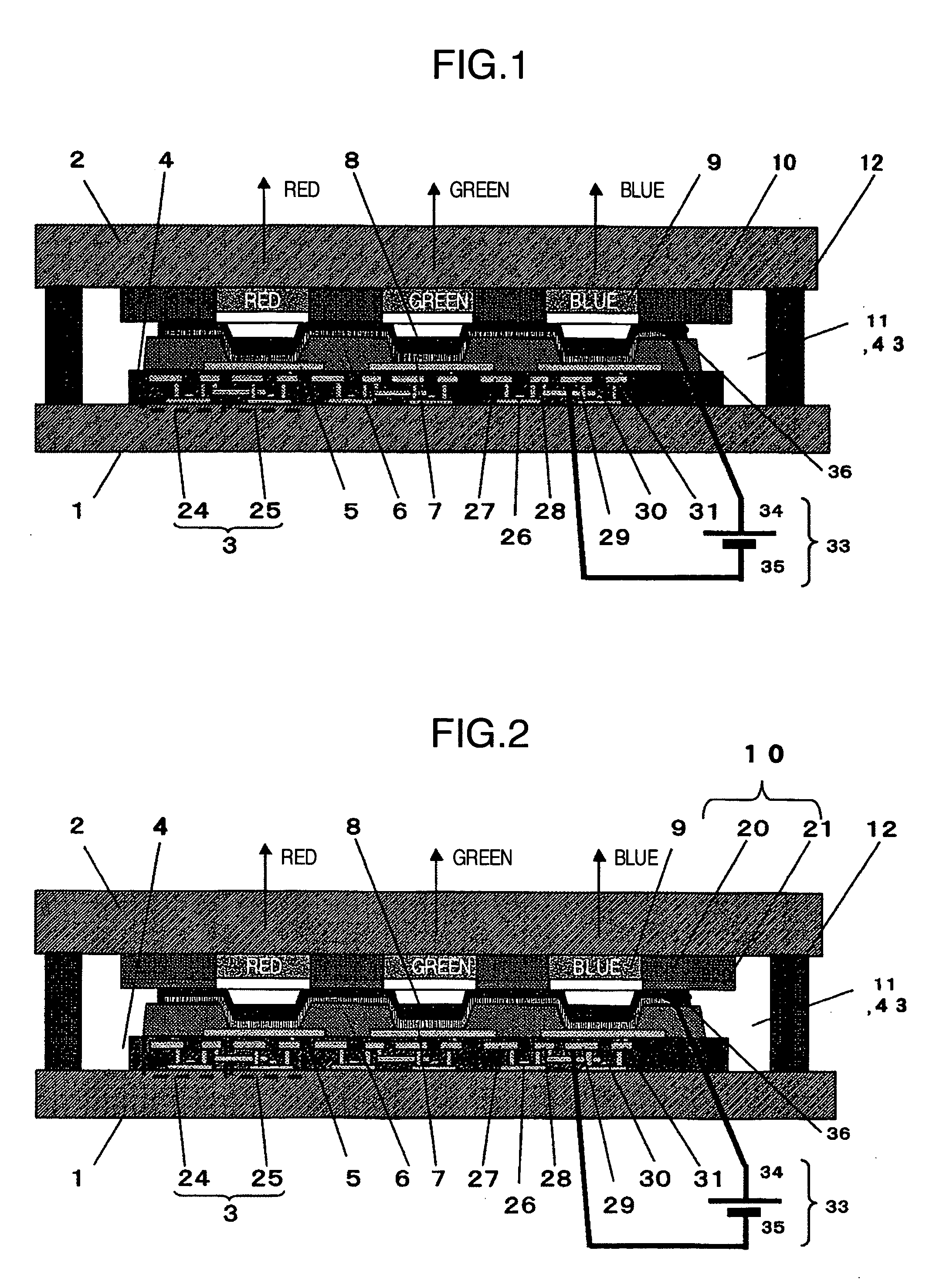Organic electroluminescence display apparatus
a display apparatus and electroluminescence technology, applied in the direction of discharge tube luminescnet screens, discharge tube/lamp details, electric discharge lamps, etc., can solve the problems of high upper electrode resistance, difficult fabrication of mask sheets for large-size products, and high resistance of top electrodes, so as to prevent uniform distribution of emitted light brightness, reduce voltage drop, and reduce aperture ratio
- Summary
- Abstract
- Description
- Claims
- Application Information
AI Technical Summary
Benefits of technology
Problems solved by technology
Method used
Image
Examples
example 1
[0053] The embodiment 1 of the organic EL display apparatus of the present invention is described by referring to the drawings. FIG. 1 is a cross-sectional view illustrating the organic EL display apparatus of the embodiment 1 of the present invention.
[0054] The organic light-emitting element formed on the first substrate 1 is composed of the organic light-emitting layer 7 and upper electrode (transparent electrode) 8 on the substrate 1, the layer 7 being composed of the lower electrode 5, first injection layer, first transport layer, light-emitting layer, second transport layer and second injection layer.
[0055] Broadly speaking, the organic light-emitting element structurally falls into one of the following types.
[0056] The first type uses the lower electrode 5 as the anode and upper transparent electrode 8 as the cathode. In this case, the first injection layer and first transport layer in the organic light-emitting element 7 work as the hole injection layer and hole transport ...
example 2
[0114]FIG. 2 is a cross-sectional view illustrating the organic EL display apparatus with an electroconductive shadow pattern of another embodiment. The electroconductive shadow pattern 10 may be of a 2-layer structure of the shadow layer 20 and electroconductive layer 21 of low resistance, as illustrated in FIG. 2. The electroconductive layer 20 can give a higher image contrast than the layer of metallic material alone, when incorporated with a black pigment. The electroconductive layer 20 may not be necessarily electroconductive. For example, the shadow layer 20 may be formed by a photo-litho process using a photosensitive polyimide dispersed with a black pigment, e.g., carbon. Moreover, it may be formed by printing depending on a line width of the shadow layer 20.
[0115] The electroconductive layer 21 of low resistance is made of a material similar to that used for the shadow pattern of the embodiment 1. The 300 nm thick upper transparent electrode 8 of ITO is formed on the first...
example 3
[0118]FIG. 3 is a cross-sectional view illustrating the organic EL display apparatus with spherical spacers. The substrates 1 and 2 are formed by a film-making method similar to that for EXAMPLE 1. An electroconductive polymer dispersed with gold-plated silica beads or metallic balls as the spherical spacer 13 is spread over the second substrate 2 by spin coating for a photo-litho process. This sets the spherical spacers 11 selectively on the electroconductive shadow pattern 10, as shown in FIG. 8 which presents the plan view. A spacer diameter of around 5 to 30 μm will be adequate. Then, the adhesive layer 12 is spread between the substrates 1 and 2 in a ring, and is cured with ultraviolet ray while these substrates are pressed to each other, to produce the organic EL display apparatus.
PUM
 Login to View More
Login to View More Abstract
Description
Claims
Application Information
 Login to View More
Login to View More - R&D
- Intellectual Property
- Life Sciences
- Materials
- Tech Scout
- Unparalleled Data Quality
- Higher Quality Content
- 60% Fewer Hallucinations
Browse by: Latest US Patents, China's latest patents, Technical Efficacy Thesaurus, Application Domain, Technology Topic, Popular Technical Reports.
© 2025 PatSnap. All rights reserved.Legal|Privacy policy|Modern Slavery Act Transparency Statement|Sitemap|About US| Contact US: help@patsnap.com



